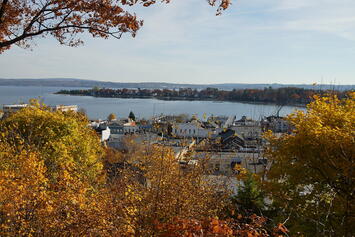
In 1873, as a result of the Homestead Act, my great-great-great grandfather, of French-Canadian descent, was awarded 160 acres of land in Leelanau County, Michigan for military service in the Civil War. Since then, Northern Michigan has been special to my family, and looking around at the landscape—its pine-studded bluffs overlooking the clearest blue lakes—it’s not difficult to see why.
America is known for its English-Protestant roots, for the pilgrims who settled the Eastern seaboard and the Anglos who descended from them. But America has a French-Catholic history, too, and Northern Michigan is a central location in that history. To this day, churches dedicated to Catholic saints and the Holy Family dot the land, reminding us of the loggers who worshiped in them and the Jesuits missionaries who served them, as far back as the seventeenth century.
Of course, families, towns, and landscapes change through the years, as they should. But change and growth should honor the histories and charms that make such places unique; otherwise cities start to feel corporate, soulless, and indistinct. Traverse City, it seems, is experiencing this first-hand. A recent piece in the Michigan Enjoyer lamented the utilitarian steel buildings and weed shops that are proliferating in the city, harming its sense of “rootedness” and subsuming it into the “global monoculture.” Will these types of changes come for the rest of Northern Michigan, too? And will residents have a say in what happens to their places?
Harbor Springs, O.W. Root pointed out, is “still a lake town” like Traverse City used to be. It’s still a place where principles like localism and tradition are important. But that could change. Unfortunately, some of the mechanisms that have weakened Traverse City’s “Up North” feel could be headed for Harbor Springs, and many residents feel they’ve been silenced from expressing concerns about them. Could the changes be part of a broader power-grab movement, on the part of central planning, over the small but beloved vacation towns that make America special?
New zoning changes in Harbor Springs that were approved on May 20 are related to the city’s pursuit of Redevelopment Ready Community (RRC) certification—a certification which, it is no coincidence to point out, Traverse City earned a few years ago in 2018. RRC, a quasi-governmental state program, encourages regions to develop more and to develop uniformly, tying grants and funding from Lansing to local governments’ willingness to comply with its “best practices.”
It’s the type of initiative that could perhaps be a godsend for struggling post-industrial cities in Michigan like Flint, Saginaw, and Inkster, where the decline of manufacturing activity has led to infrastructural disintegration and poverty. But it doesn’t make much sense in Harbor Springs, where the quaint, historic main street is an important tourist attraction and where per-capita income is much higher than the state average.
Read the rest of this piece at Front Porch Republic.
Nora Kenney is a midwestern transplant, working in public policy and writing from New York City. She has a B.A. and M.A. in English Literature from the University of Notre Dame. Her work has appeared in City Journal, the American Conservative, National Review, and more.
Photo: Harbor Springs, Michigan, by Greg Marks, via Flickr under CC 2.0 License.












